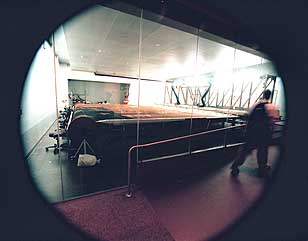Grand Old Flag
You're a grand old flag, You're a high flying flag And forever in peace may you wave. You're the emblem of The land I love. The home of the free and the brave. Ev'ry heart beats true 'neath the Red, White and Blue, Where there's never a boast or brag. Should auld acquaintance be forgot, Keep your eye on the grand old flag.
You're a grand old flag,
|
About This Music

![]()
Tuesday, July 4, 2000
By LANCE GAY, Scripps Howard News Service
WASHINGTON — It's official: Old Glory is brighter than ever this July 4th — and
she's got several centuries of life left.
That's the conclusion of the Smithsonian Museum, which issued an interim report
on its first year of work on conserving the giant Star-Spangled Banner that flew
over Fort McHenry during a 25-hour bombardment at the Battle of Baltimore Sept.
12-14, 1814.

Smithsonian conservators work on the flag that inspired the National Anthem. Visitors to the Smithsonian National Museum of American History in Washington, D.C., can observe the progress of the treatment of the flag, as well as view an exhibition about the history of the 185-year-old flag and its preservation at the Smithsonian.
Hank Wilson/Scripps Howard News Service
Smithsonian conservators work on the flag that inspired the National Anthem. Visitors to the Smithsonian National Museum of American History in Washington, D.C., can observe the progress of the treatment of the flag, as well as view an exhibition about the history of the 185-year-old flag and its preservation at the Smithsonian. Hank Wilson/Scripps Howard News Service
Curators say that in the process of cleaning the 34-by-30-foot flag, they found that the original bright colors had been obscured by stitches put in during a 1914 restoration effort.
After removing 1.7 million stitches that attached the original flag to a linen backing, the natural reds (made from cochineal beetle juices) and the blues (from indigo) are deeper and more vibrant than anyone knew.
They also located 27 patches on the flag they didn't know were there — apparently also the product of previous conservation efforts.
"In the 1860s the historical accounts are consistent that there were 11 holes apparently made by the British during the bombardment," said Smithsonian historian Lonn Taylor, whose book "The Star Spangled Banner: The Flag that Inspired the National Anthem" is being published this weekend (New York, Abrams, $9.95).
The cause of the other holes isn't known, but Taylor noted that the family that previously owned the flag allowed veterans of the bombardment and guests to cut off portions of the flag as souvenirs. That's the reason it's three feet shorter than when it was put together under a government contract by Baltimore flag-maker Mary Pickersgill.
She received $405.90 for the flag and $168.54 for a smaller version. It is made of English woolen bunting, with cotton stars. Today Old Glory is being restored at a cost of $18 million, partially paid by private donations.

Smithsonian conservators, La Tasha Harris and Amy Venske, inspect the flag that inspired the National Anthem.
Hank Wilson/Scripps Howard News Service
Smithsonian conservators, La Tasha Harris and Amy Venske, inspect the flag that inspired the National Anthem. Hank Wilson/Scripps Howard News Service
Taylor said there are still many mysteries left about the Star-Spangled Banner. The original contract for Old Glory survives, but he said he can't find any documentation that allowed Army Maj. George Armistead, commander of Fort McHenry during the battle, to keep the flag as a memento.
Armistead died a lieutenant colonel in 1818, and his family in Baltimore kept the flag as a prized heirloom of his career. It was brought out on several occasions, and flown over Fort McHenry in 1824 to honor visiting French Gen. Lafayette, and for veterans during the 25th anniversary of the fort's bombardment. It was used at the Whig convention in Baltimore in 1840 and displayed at the Philadelphia Centennial celebration in 1876. It last shown in a parade in 1880, celebrating the 200th anniversary of Baltimore.
There's writing on the Stars and Stripes, too, put there by Armistead's family. On one of the stars, Armistead's daughter Georgiana wrote: "This is a relic of my father's fame ... " followed by a hole. Taylor surmises that she wrote this on the flag, intending to donate it to the country for the 1876 centennial celebration before changing her mind.
Amistead's grandson gave the flag to the Smithsonian in 1914, when conservators stitched a linen backing to the flag so it could hang on the museum wall.
There's also an applied letter "A" on the flag, with a smaller "B" superimposed on it. Taylor said the "A" is for Armistead, but he hasn't figured out what the letter "B" represents.
The conservation project, which is being done in the hall of the Smithsonian's American History Museum, will continue for another two years.

On Oct. 19, 1998, the National Museum of American History embarked upon the latest phase of a long-term project to preserve and protect its best-known artifact and the single most powerful symbol of the American nation — the Star-Spangled Banner. Above, Smithsonian conservators work on the flag that inspired the National Anthem.
Hank Wilson/Scripps Howard News Service

A visitor to the Smithsonian National Museum of American History walks past conservators working on the flag that inspired the National Anthem. The laboratory housing the conservation effort is located in the west wing of the second floor of the Smithsonian.
Hank Wilson/Scripps Howard News Service
On Oct. 19, 1998, the National Museum of American History embarked upon the latest phase of a long-term project to preserve and protect its best-known artifact and the single most powerful symbol of the American nation — the Star-Spangled Banner. Above, Smithsonian conservators work on the flag that inspired the National Anthem. Hank Wilson/Scripps Howard News Service
A visitor to the Smithsonian National Museum of American History walks past conservators working on the flag that inspired the National Anthem. The laboratory housing the conservation effort is located in the west wing of the second floor of the Smithsonian. Hank Wilson/Scripps Howard News Service
